Spring time in central Pennsylvania is hatch time, which means numerous mayflies, caddis, and stoneflies hatching in strong numbers. Along with ideal water conditions (clarity and depth), these hatches create a perfect storm for the angler during which all tactical options are on the table – dry flies, wet flies and nymphing. During a hatch, one of the deadliest approaches can often be swinging wets, emergers and/or soft hackles. Unfortunately, wet fly tactics have become sort of a lost art with many of today’s anglers. This is a shame because wet flies, like any given tactic during the right conditions, can be the fly fisher’s best way to consistently catch fish. This is with good reason. Wet flies are intended to imitate emergers, the most vulnerable stage of the insect’s life during which it is transitioning from larva stage to adult. Trout know these insects represent an easy meal and will often focus on emergers. The question that often faces anglers is whether, at any given time during a hatch, whether it would be more effective to switch to swinging wet flies or stick with their nymph rig. The answer may be a little bit of both.
Fortunately, by meshing nymphing with wet fly tactics, there is a way to kill two birds with one stone.
Typically, trout need to be in an active feeding state in order for wet fly tactics to work. But, despite how effective wet flies can be, there are few times when wet flies will out produce nymphs. This is why I rarely stick to a rig with all wets. Instead, I’ll build a wet fly approach into my nymphing rig.
While there are countless ways you can build wet flies into your nymphing rig, one of my favorite methods is to tie a wet fly off the bend of a nymph. For example, as the sulphur mayfly actions begins to pick up here in central Pennsylvania, I’ll tie a yellow Puff Daddy CDC off the bend of my favorite sulphur nymph. I’ll place a split shot (size/amount depending on water depth/speed) approximately 8-10 inches above my sulphur nymph. Then I attach a 12-16 inches of tippet to the bend of the sulphur nymph and tie on the yellow Puff Daddy.
The tactic is simple and is best when fished with a tight line presentation – which means not using an indicator. First, cast up and across stream to dead drift your rig. I prefer up and across rather than straight up as this angle will allow you to better manage your line and put you into a better position to begin the swing.
As the flies begin to drift straight across from you (i.e. the point where you can no longer lead the nymphs without slack accumulating) slowly elevate the rod tip. This lift will take out any slack that may have accumulated during the dead drift. The key is not to pull your flies off the bottom but simply to eliminate any slack. Once the rod is elevated and slack is taken out of the rig, now it’s time to swing your rig.
As the flies drift below you, keep the rod tip pointed in the direction of the line and/or leader on the water and rotate your shoulders so that you begin pulling the rig across the stream. This is when the soft hackle pattern on the point works its magic. As the flies slowly swing through the current, the wet fly will flutter immediately below the surface, imitating an emerging insect. When a fish strikes, it will usually hook itself due to the tension created during the swing so a hook set is usually not needed.
It is important to keep your rod tip positioned in a way that will create enough tension to detect a strike but not too much – allowing a fish to break the tippet during a strike. Strikes during the swing are typically aggressive, which means the rod tip must be in a position to absorb an aggressive take. To create this shock absorber, simply keep your rod hand low to the water but break the wrist so the rod tip is angled upward. In other words: you don’t want your rod, line, and leader to form a straight line during the swing. When all three are in a straight line, there is no cushion for a hard strike and you will likely break off the fly.
By building a wet fly into your nymphing rig and putting a swing into your presentation, you can easily double your chances when insects are emerging and trout are actively feeding.




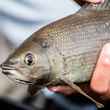



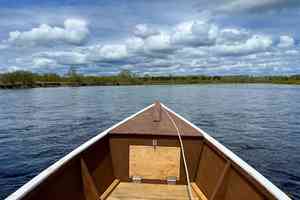







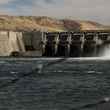





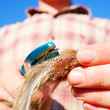



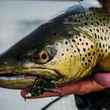
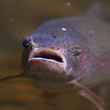
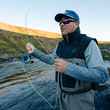
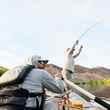

Comments
Glenn Dotter replied on Permalink
Growing up in the Poconos, when I was learning to fly fish 60 years ago, wet flies were the most common method of fishing the Broadhead, Bushkills, Shohola, and all the others. The slow lift mentioned in the article was and still is known as the Liesenring Lift after Jim Liesenring. My teachers Russ Dotter and Dick Rader showed how effective the lift was at the end of the swing. Our standard setup was 3 wet flies all on droppers.
Today I live and fish the waters of Colorado. When fishing sub surface, I still use 3 flies. I rarely use droppers rather I tie a length of tippett to they of the previous fly and so on with the next. This allows each fly to wiggle and wobble in the drift. Wets and nymphs are all wet flies in the sense they are fished below the surface. The important thing is how they are fished. But Jim Liesenring's lift works to create the emergence of each bug you have on your line regardless of how you have them tied. Be flexible. That is the fun and enjoyment of the sport. Good article!
Glenn Dotter replied on Permalink
Fat fingers make type O's. When I tye my 2and and 3rd flies on I tye the tippett to the eye of the previous fly instead of around the hook bend. This allows each fly to flutter more naturally. On a dry dropper rig you have to tye the dropper to the bend so the dry floats properly.
Pages